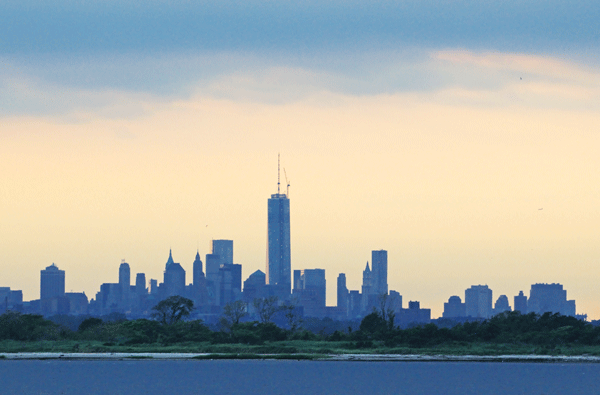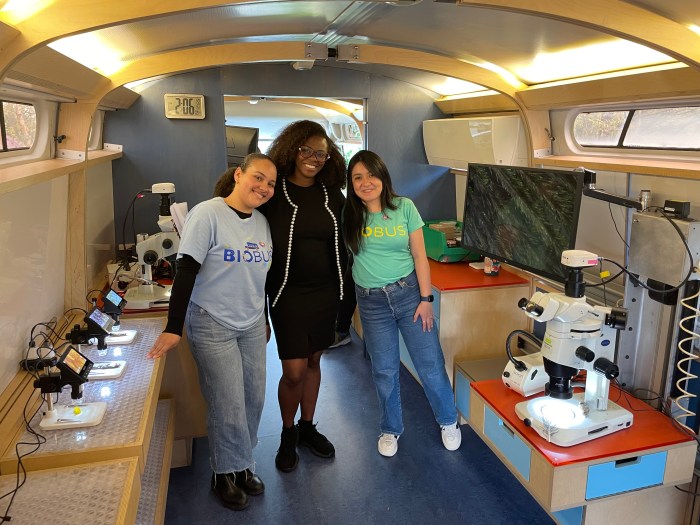
Lower Manhattan as viewed from Jamaica Bay.
BY TERESE LOEB KREUZER | Ospreys, terns, falcons, gulls and glossy ibises fly over Jamaica Bay with the skyline of Manhattan clearly visible in the distance. The vast wildlife refuge, which straddles Brooklyn and Queens, is one of the largest urban wildlife preserves in the country.
This summer, the New York Audubon Society organized three tours of Jamaica Bay aboard New York Water Taxi. They showcased the beauty of the area — and its vulnerability.
Breezy Point is on a barrier island, Audubon guide Gabriel Willow pointed out as the boat passed houses still crumpled by Sandy damage. Some still had plywood-boarded windows, holes in the roof, cracks in the walls.
“Breezy Point and the Rockaways were devastated by Superstorm Sandy, partially because you have dense housing development on a sand dune,” he said.
“Tidal marshes are usually the first landscape to go,” he observed. “They don’t seem to be useful to us so they’re either dredged for shipping or filled in for building. We’re starting to realize our folly.”
Willow said that these marshes clean toxins from the water and are barriers against storm surges. “The silver lining of the storm is that now there will be renewed focus on restoring coastal ecosystems.”
What naturalists and scientists have long realized has become abundantly evident to policy makers. Jamaica Bay has officially been designated a laboratory to study how climate change and sea level rise affect wildlife, the natural environment and the communities that line its shores.
Last summer, New York City and the National Park Service signed an agreement to co-manage Jamaica Bay’s nearly 10,000 acres of federal and city-owned parkland. Plans for a world-class science and resilience institute were also put forward at that time, to be financed by a public/private partnership.
On Aug. 12, representatives of the city and federal governments and of several educational and research institutions gathered at Riis Landing on the Rockaway peninsula to announce the formation of a Science and Resilience Institute to be led by the City University of New York in partnership with the Rockefeller Foundation.
The institute will enlist the resources and expertise of numerous other partners as well including Columbia, Cornell, Rutgers and Stony Brook Universities, the Stevens Institute of Technology and the Wildlife Conservation Society.
The city has made an initial commitment of $3 million toward the Institute.
Mayor Michael Bloomberg described Jamaica Bay as “one of the greatest natural treasures that any city has within its borders” and alluded to the “terrible damage” that had been done to the area by Superstorm Sandy. Work to restore and protect that area is “urgent,” he said.
“Climate change is real,” said U.S. Housing and Urban Development Secretary Shaun Donovan. “It’s posing real and growing threats to our neighborhoods.” He said that we need to build communities that address these growing challenges. “We can’t just build back the way we were.”
Donovan said that, “Recent studies suggest that green infrastructure can be even more effective than gray infrastructure like seawalls, levees and tidal gates” in offering protection.
Bloomberg said that a new beach grass nursery is being planted at Floyd Bennett Field, which fronts on Jamaica Bay. It will help the City and the National Park Service grow acres of “made in New York beach grass,” he said.
Sally Jewell, U.S. Secretary of the Interior, said that Jamaica Bay’s green infrastructure protected a number of structures from Superstorm Sandy. “Jamaica Bay is going to be a perfect, perfect place for the whole country to learn about resilience,” she said, and how natural and manmade ecosystems will act.
Jewell announced that the Department of the Interior was launching a $100 million competitive grant to get proposals on how to learn from Sandy in Jamaica Bay.
The mayor also announced the formation of the Jamaica Bay/Rockaway Parks Conservancy, a partnership between the National Park Service and the City. It will help raise funds for the parkland covered by the agreement and will collaborate with Jamaica Bay communities. In addition, it will work to encourage visitation to the area. The Conservancy will be chaired by Tom Secunda, a philanthropist and one of the founders of Bloomberg LP.
The Science and Resilience Institute will initially be housed on the campus of Brooklyn College. One of its first activities will be to organize an international symposium with the Rockefeller Foundation on Oct. 17 and 18 called, “Urban Resilience in an Era of Climate Change.” It will bring together global leaders in the field to address an issue of importance to all world cities that border coastal areas.

















